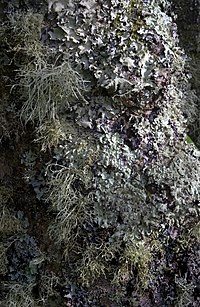
Photo from wikipedia
Fungal communities associated to three epiphytic lichens active against Candida, were investigated using culture-based methods We hypothetized that associated fungi would contribute to lichens activities. The ability of specific fungi… Click to show full abstract
Fungal communities associated to three epiphytic lichens active against Candida, were investigated using culture-based methods We hypothetized that associated fungi would contribute to lichens activities. The ability of specific fungi to grow inside or outside lichens was investigated. To detect biogenesis pathways involved in the production of secondary metabolites, genes coding for nonribosomal peptide synthetase (NRPS) and polyketide synthase I (PKS I) were screened by PCR from fungal DNA extracts. Both endo and epilichenic communities were isolated from two fructicose (Evernia prunastri and Ramalina fastigiata) and one foliose (Pleurosticta acetabulum) lichens. A total of 86 endolichenic and 114 epilichenic isolates were obtained, corresponding to 18 and 24 phylogenetic groups respectively suggesting a wide diversity of fungi. The communities and the species richness were distinct between the three lichens which hosted potentially new fungal species. Additionally, the endo- and epilichenic communities differed in their composition: Sordariomycetes were particularly abundant among endolichenic fungi and Dothideomycetes among epilichenic fungi. Only a few fungi colonized both habitats, such as S. fimicola, Cladosporium sp1 and Botrytis cinerea. Interestingly, Nemania serpens (with several genotypes) was the most abundant endolichenic fungus (53% of isolates) and was shared by the three lichens. Finally, 12 out of 36 phylogenetic groups revealed the presence of genes coding for nonribosomal peptide synthetase (NRPs) and polyketide synthase I (PKS I). This study shows that common lichens are reservoirs of diverse fungal communities, which could potentially contribute to global activity of the lichen and, therefore, deserve to be isolated for further chemical studies.
Journal Title: Microbiological research
Year Published: 2018
Link to full text (if available)
Share on Social Media: Sign Up to like & get
recommendations!